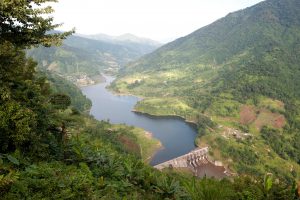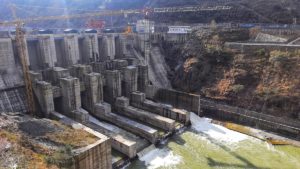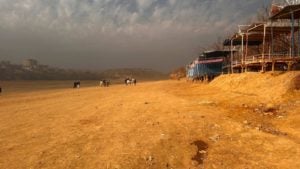On 27 December 2022, the apex body at India’s Ministry of Environment, Forest and Climate Change (MoEFCC) declined to give forest clearance to the Etalin hydroelectric project in Arunachal Pradesh. In its recommendation, the Forest Advisory Committee (FAC) advised that the state government further assess how to protect the Dibang Valley area’s rich biodiversity. This was the sixth time the 3,097-megawatt project – which, if built, would be the largest dam in India in terms of installed capacity – has been refused forest clearance since it was first envisaged in 2008.
The news of the denial of clearance for Etalin is a reminder of too-often-forgotten uncomfortable truths about the chaos and destruction caused by hydropower projects in Arunachal Pradesh. These concerns are particularly important now, after news earlier this year that the government is moving forward on five dams in Arunachal Pradesh, in addition to approving the 2,880 MW Dibang mega-dam, whose installed capacity would be just a little less than that envisaged for Etalin.
Backdrop to Etalin – a sorry story
Within a short span of time in 2008, the government of Arunachal Pradesh signed more than 130 Memoranda of Understanding (MoUs) with power companies for hydropower projects ranging in size from 5 MW to 4,000 MW. The number of MoUs, and the speed at which they were signed, led the environment minister at the time Jairam Ramesh to describe the trend as an “MoU virus”. This virus has not only been destructive for biodiversity, but has also infected the democratic political institutions and indigenous communities of the state.
As the approvals were pushed for, every possible violation of norms and procedures was committed. In 2010, a report by the Comptroller and Auditor General of India (CAG) declared that Arunachal Pradesh’s Department of Hydropower Development “does not have proper planning process” and that it went ahead with several projects based on inadequate information and lacking rigorous environmental impact assessment (EIA). In a 2013 report, the CAG said that an absence of open tendering and failure to take actions like forfeiture of security deposits had led to financial losses. Activists have described “huge corruption” in certain hydropower projects.
Mamang Dai, the Arunachal Pradesh-based novelist, poet and journalist, spoke for many across the state when she described the development brought by hydropower as “an invasion”, deploring the labelling of those who protest as “illiterate”.
Organisations such as the Siang People’s Forum, Adi Student’s Union and Save Mon Region Federation have spearheaded an anti-dam movement and protests across the state. In turn, these groups were branded as ‘Maoists’ by the authorities, in reference to extremist Left militias that are banned by the state. Activist Bamang Tago, a member of the Idu Mishi tribe, has stated that this gave license to the police and Central Reserve Police Force to attack protesters and sabotage the movement.
There are reports of efforts to inhibit public participation. Research published in 2014 by the Institute of Chinese Studies, a think tank based in Delhi and funded by the Indian government, detailed allegations of tactics designed to lessen villagers’ ability to protest against dams, which include dam-building companies distributing opium and bribing leaders. In 2012, there was a failed assassination attempt on Tongam Rina, associate editor of The Arunachal Times, who had written critically on hydropower projects in the state.
India’s biodiversity pledges and Etalin
The rush to build large hydropower dams in Arunachal Pradesh clashes with India’s international aspirations. On 22 December, just a few days before the FAC refused forest clearance to Etalin, the world’s governments adopted the Kunming-Montreal Global Biodiversity Framework, aiming to halt species extinction and loss of biodiversity. One of the agreements specifies that countries will “Ensure and enable that by 2030 at least 30 per cent of terrestrial, inland water, and of coastal and marine areas, especially areas of particular importance for biodiversity and ecosystem functions and services are effectively conserved and managed” while “recognising and respecting the rights of indigenous peoples and local communities, including over their traditional territories.”
Since Arunachal Pradesh, and the whole of the Eastern Himalayas, is considered one of the world’s ‘biodiversity hotspots’, policymakers need to carefully consider the sentiments of indigenous tribal communities while undertaking any kind of developmental project.
In the case of the proposed Etalin project, the conservation of wildlife, especially tigers, has been a major bone of contention between the Idu Mishmi tribe and authorities. Following the discovery of tigers in and around the Dibang Valley in 2018, the National Tiger Conservation Authority decided to declare the Dibang Wildlife Sanctuary a tiger reserve – a plan that involved fences and patrol guards.
This was rejected by the Idu Mishmi community, who stressed to the authorities that they consider the tiger a ‘brother’ and have been living alongside the apex predator for centuries. They argued, therefore, that the conservation model should be “based on deep-rooted cultural values and beliefs”. The Idu Mishmi also consider the Talo River, on which a dam for the Etalin project is planned, sacred, as they believe that the souls of the deceased are guided along it by Idu shamans to reach their heavenly abode.
The FAC minutes from 27 December show that preserving biodiversity was a focal point in the decision to reject Etalin for forest clearance. The FAC demanded that the state government further assess both the number of trees to be felled in consultation with the Forest Survey of India and the protection of wildlife. Having noted the dissent of several organisations to the Etalin project as well as “already approved projects”, the Committee also “requested the State Govt. to review the status of all approved projects” and submit a report on the projects’ compliance with FAC conditions “at the earliest”.
The FAC decision is a welcome step. It not only limits the Etalin project, but also commits the government of Arunachal Pradesh to review already approved projects like the Dibang mega-dam project and diligently implement environmental impact assessments (EIAs) before applying for approval of any new projects in the state.
The Pakke Declaration – too much to hope for?
There are some faint glimmers of hope for biodiversity conservation coming from within Arunachal Pradesh. In November 2021, the state government adopted the ‘Pakke Declaration’, which assures its citizens it will act on climate change and biodiversity loss. In April 2022, the Arunachal Pradesh State Biodiversity Board and World Wildlife Fund-India signed an agreement to prepare a State Biodiversity Strategy and Action Plan (SBSAP), in which Mama Natung – Arunachal Pradesh’s environment and forest minister – declared that the SBSAP will align with the post-2020 Global Biodiversity Framework and Pakke Declaration. Such measures by the state government mean the people of Arunachal Pradesh can hope for real progress in halting biodiversity loss and respecting the rights of indigenous peoples.
As United Nations Secretary-General António Guterres has pointed out, biodiversity is facing an existential threat as humanity continues to wage “war on nature”. In order to “make peace with nature”, it will be crucial to integrate biodiversity concerns into decision-making tools like EIAs.
Hopefully the Etalin project – and the five hydropower projects that in January were transferred from private power companies to central public sector undertakings – will be an example of this.











